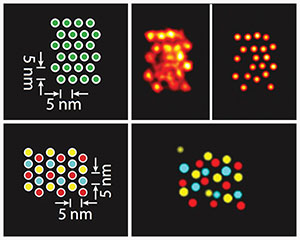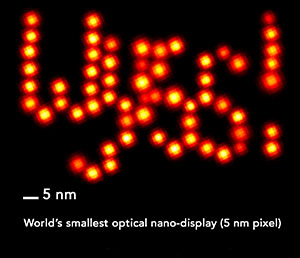A new method pushes the frontier in imaging resolution, with the potential to distinguish individual features in single molecules

(BOSTON) — Proteins mostly do not work in isolation but rather make up larger complexes like the molecular machines that enable cells to communicate with each other, move cargo around in their interiors or replicate their DNA. Our ability to observe and track each individual protein within these machines is crucial to our ultimate understanding of these processes. Yet, the advent of super-resolution microscopy that has allowed researchers to start visualizing closely positioned molecules or molecular complexes with 10-20 nanometer resolution is not powerful enough to distinguish individual molecular features within those densely packed complexes.
A team at Harvard’s Wyss Institute for Biologically Inspired Engineering led by Core Faculty member Peng Yin, Ph.D., has, for the first time, been able to tell apart features distanced only 5 nanometers from each other in a densely packed, single molecular structure and to achieve the so far highest resolution in optical microscopy. Reported on July 4 in a study in Nature Nanotechnology, the technology, also called “discrete molecular imaging” (DMI), enhances the team’s DNA nanotechnology-powered super-resolution microscopy platform with an integrated set of new imaging methods.
Last year, the opportunity to enable researchers with inexpensive super-resolution microscopy using DNA-PAINT-based technologies led the Wyss Institute to launch its spin-off Ultivue Inc.
“The ultra-high resolution of DMI advances the DNA-PAINT platform one step further towards the vision of providing the ultimate view of biology. With this new power of resolution and the ability to focus on individual molecular features, DMI complements current structural biology methods like X-ray crystallography and cryo-electron microscopy. It opens up a way for researchers to study molecular conformations and heterogeneities in single multi-component complexes, and provides an easy, fast and multiplexed method for the structural analysis of many samples in parallel” said Peng Yin, who is also Professor of Systems Biology at Harvard Medical School.

DNA-PAINT technologies, developed by Yin and his team are based on the transient binding of two complementary short DNA strands, one being attached to the molecular target that the researchers aim to visualize and the other attached to a fluorescent dye. Repeated cycles of binding and unbinding create a very defined blinking behavior of the dye at the target site, which is highly programmable by the choice of DNA strands and has now been further exploited by the team’s current work to achieve ultra-high resolution imaging.
“By further harnessing key aspects underlying the blinking conditions in our DNA-PAINT-based technologies and developing a novel method that compensates for tiny but extremely disruptive movements of the microscope stage that carries the samples, we managed to additionally boost the potential beyond what has been possible so far in super-resolution microscopy,” said Mingjie Dai, who is the study’s first author and a Graduate Student working with Yin.
In addition, the study was co-authored by Ralf Jungmann, Ph.D., a former Postdoctoral Fellow on Yin’s team and now a Group Leader at the Max Planck Institute of Biochemistry at the Ludwig Maximilian University in Munich, Germany.
The Wyss Institute’s scientists have benchmarked the ultra-high resolution of DMI using synthetic DNA nanostructures. Next, the researchers plan to apply the technology to actual biological complexes such as the protein complex that duplicates DNA in dividing cells or cell surface receptors binding their ligands.
“Peng Yin and his team have yet again broken through barriers never before possible by leveraging the power of programmable DNA, not for information storage, but create nanoscale ‘molecular instruments’ that carry out defined tasks and readout what they analyze. This new advancement to their DNA-powered super-resolution imaging platform is an amazing feat that has the potential to uncover the inner workings of cells at the single molecule level using conventional microscopes that are available in common biology laboratories,” said Donald Ingber, M.D., Ph.D., who is the Judah Folkman Professor of Vascular Biology at Harvard Medical School and the Vascular Biology Program at Boston Children’s Hospital, and also Professor of Bioengineering at the Harvard John A. Paulson School of Engineering and Applied Sciences.

